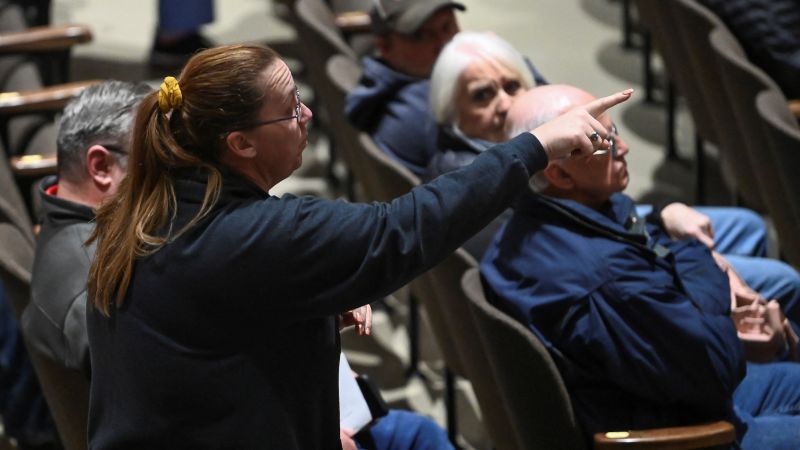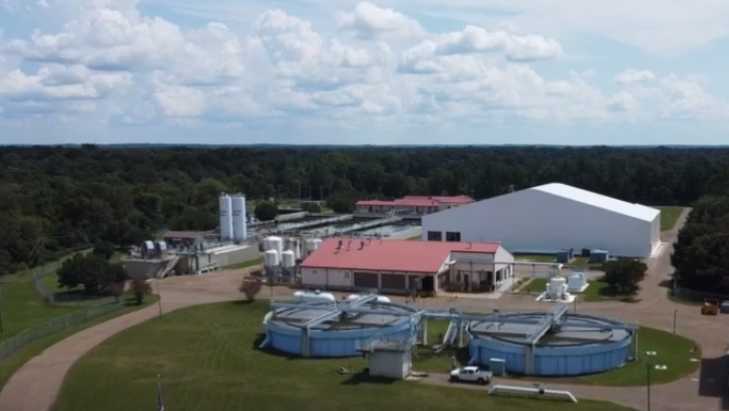CNN
—
Angry residents repeatedly interrupted a railroad company official at a contentious town hall in East Palestine, Ohio, on Thursday, with questions and concerns regarding cleanup efforts at the site of a toxic train derailment nearly one month ago.
“We’re going to do the right thing, we’re going to clean up the site,” said Norfolk Southern representative Darrell Wilson as shouts were raised from those in attendance. “We’re going to test until we get all the contamination gone.”
“No, you’re not!” one voice cried out.
Norfolk Southern, the operator of the train that derailed on the evening of February 3, has faced continued criticism from residents in the area, some of whom report illnesses they believe stem from the crash.
After the derailment, the dangerous chemical vinyl chloride was released and burned to prevent a potentially deadly explosion, and other chemicals of concern that were being transported are feared to have leaked into the surrounding ecosystem in Ohio and Pennsylvania – with potentially damaging health consequences. Crews involved in the cleanup have also reported medical symptoms, according to a letter on behalf of workers’ unions.
During Thursday’s town hall, officials with the Environmental Protection Agency said Norfolk Southern’s plans to remediate the site were under consideration that night, and Mark Durno, Regional Response Coordinator for the EPA, told CNN’s Brenda Goodman that teams were poised to approve it.
That paved the way for the process to begin Friday morning. The EPA has ordered the freight rail company to fully clean up the site of the wreck.
However, an EPA source with detailed knowledge of the situation told CNN Friday the agency has not fully accepted the remediation plan and expects to receive an updated draft by next week. While preliminary work has begun on the tracks, the excavation of soil has not begun, the source explained.
Remediation started a quarter mile from the derailment site on the south track, video from CNN’s Miguel Marquez shows.
The process will involve removing one side of the tracks, digging out the contaminated soil, conducting sampling, and then replacing the tracks. The same would then be done on the side of the other tracks. Around 1,900 feet of rail will be pulled up on both sets of tracks, Ohio Gov. Mike DeWine’s office said.
Also Friday, a team of scientists from Carnegie Mellon University and Texas A&M said a mobile lab being used to monitor for air pollution at the site of the derailment found a chemical that could potentially be of concern at higher levels than normal.
While work is being done on the south track, trains will continue to run on the north track where there are still tank cars that can’t be removed until they’re inspected, Wilson said.
“The sooner they pick it up, the sooner they can get it out of town,” EPA Region 5 Administrator Debra Shore said at the town hall. “This is going to be a complicated, big project.”
Officials are hoping to begin the process on the north side around March 28, with the entire process finishing by the end of April, Wilson said.
Approximately 3.2 million gallons of liquid waste and about 1,700 tons of solid waste have already been removed from the derailment site, the governor’s office announced in a news release Friday, citing the state’s EPA. The wastewater and solid waste have been transported to sites in Ohio and elsewhere, including Michigan, Indiana and Texas, according to the release.
“We’re very sorry for what happened. We feel horrible about it,” Wilson said – which spurred an uproar from the crowd.

Last week, Ohio Lt. Gov. Jon Husted had suggested the company should temporarily or permanently relocate residents who feel unsafe.
“I think that the railroad should consider buying property of people who may not feel safe or would want to relocate as a result of the spill,” he told CNN on February 23. “This is the railroad’s responsibility, and it’s up to the government officials at the federal, state and local levels to hold them accountable and do right by the citizens of East Palestine.”
In response to a resident’s question at the town hall meeting, Wilson said there has not been any talk about relocating residents.
“This will be an evolving conversation that’s going to go on for quite a while,” he said, adding the company will continue to collect data to inform its decisions.
This week, Norfolk Southern CEO Alan Shaw sold $448,000 worth of the company’s stock and Shaw personally set up a $445,000 scholarship fund for seniors at East Palestine High School that an unspecified number of students will be able to use to attend college or vocational schools.
Norfolk Southern did not respond to request for comments about the stock sale, and whether Shaw plans to reduce or donate more of his salary in the wake of the accident.
In addition to the site cleanup, the EPA is requiring Norfolk Southern to test directly for the presence of dioxins – compounds considered to have significant toxicity and can cause disease. The testing will be conducted with oversight by the agency, according to a statement released Thursday.
The EPA will direct immediate cleanup of the area if dioxins are found at a level that poses any unacceptable risk to human health or the environment, according to the statement. The EPA will also require Norfolk Southern to conduct a background study to compare any dioxin levels around East Palestine to dioxin levels in other areas not impacted by the train derailment.
The agency noted dioxins may be found in the environment as a result of common processes such as burning wood or coal, and they break down slowly, so the source of dioxins found in an area may be uncertain.
The effort comes in direct response to concerns the EPA heard from East Palestine residents, the statement said.
“This action builds on EPA’s bipartisan efforts alongside our local, state, and federal partners to earn the trust of this community and ensure all residents have the reassurances they need to feel safe at home once again,” EPA Administrator Michael Regan said.
As of February 28, the EPA had collected at least 115 samples in the potentially impacted area, which include samples of air, soils, surface water, and sediments, the statement said.
To date, EPA’s monitoring for indicator chemicals has suggested a low probability for release of dioxin from this incident, according to the statement.
The mobile lab monitoring for air pollution found acrolein – a potential chemical of concern – at higher levels than normal, the scientists from Carnegie Mellon University and Texas A&M said at a news briefing Friday. The researchers said the levels of acrolein were notably high at the derailment site. They don’t know what impact the chemical could have on residents’ health, they said.
When compared with levels in downtown Pittsburgh, levels of acrolein in the East Palestine area ranged from five times lower to three times higher on February 20.
Acrolein is a clear liquid at room temperature and it is toxic; it can cause inflammation and irritation of the skin, respiratory tract and mucous membranes, according to the Centers for Disease Control and Prevention. The chemical is used to control plants, algae, rodents and microorganisms.
While acrolein was not on the list of chemicals carried on the derailed train cars, it can be created during the combustion of fuels, wood and plastics, according to the International Agency for Research on Cancer.
The mobile lab, located in a van, sucks in air from above the driver’s head as it slowly drives around public roads. It collects data points every second, the team said, and the unit has sensitive equipment that can measure pollution in the parts per billion; it’s possible to identify even minute pollutant concentrations that may otherwise be untraceable.
Information in the new analysis was collected on February 20 and 21, university researchers said.
The lab found that values of benzene, toluene, xylenes and vinyl chloride were below the minimal risk levels for intermediate exposures as set by the Agency for Toxic Substances and Disease Registry.
The team said there were no “hotspots,” found in their mobile sampling and that the analysis corroborates the data collected by the federal EPA between February 8 and February 22.
Note:- (Not all news on the site expresses the point of view of the site, but we transmit this news automatically and translate it through programmatic technology on the site and not from a human editor. The content is auto-generated from a syndicated feed.))



